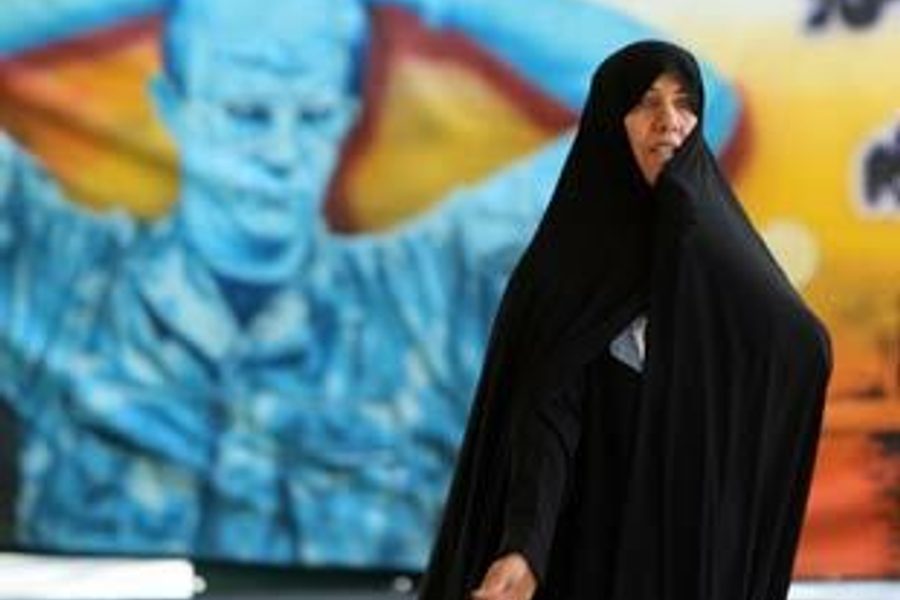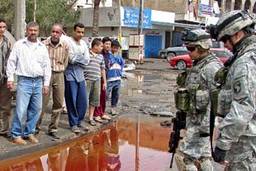
Quick: Who is the strategic victor, to date, of the war in Iraq? Nearly everyone outside the Bush administration (and perhaps some within it) would answer: the Islamic Republic of Iran.
The catastrophe of the U.S. occupation of Iraq has bolstered the clerical regime in Tehran, while souring ordinary Iranians on the prospect of U.S.-delivered “democracy.” The occupation has done so by emplacing Iranian-backed Shiite Islamists in power in Baghdad and cooling the jets of those in Washington hoping to “shock and awe” Iran’s mullahs.
Meanwhile, Iran has proceeded with its efforts to obtain enriched uranium, the material it needs for the peaceful generation of nuclear power, but that the international community fears it would use to manufacture an atomic bomb.
Top Democrats have periodically seen in Iran’s rise an opportunity to cast President George W. Bush as weak on national security. Road-testing this approach in early 2006, Sen. Hillary Clinton (D-N.Y.) declared, “I believe we lost critical time in dealing with Iran because the White House chose to downplay the threats and to outsource the negotiations” over uranium enrichment to the Europeans.
On Sept. 26, 2007, she voted for a measure co-sponsored by Iran hawk, Sen. Joseph Lieberman (I-Conn.), urging Bush to label Iran’s Revolutionary Guards a “terrorist organization” arming and funding Shiite militias in Iraq. Two days earlier, Clinton’s rival Sen. Barack Obama (D-Ill.) had sent a statement to a pro-Israel rally in New York calling Iran “the greatest strategic challenge to America in the Middle East in a generation.”
Such hyping of the Persian peril has coexisted uneasily in Democratic and foreign policy establishment rhetoric with the specter of another military misadventure by the Bush administration. Clinton’s rivals for the Democratic nomination inveighed against her Sept. 26 vote, especially after the White House designated the Revolutionary Guards a “proliferator of weapons of mass destruction,” and its Quds Force a “supporter of terrorism,” on Oct. 25.
Former Sen. John Edwards accused Clinton of aiding “George Bush, Dick Cheney and the neocon warmongers” and their references to “World War III.” Then, the worry that Bush would attack Iran evaporated with the release in early December of declassified portions of a new National Intelligence Estimate (NIE).
The NIE, in an abrupt reversal of the U.S. intelligence community’s previous best guess, stated that Iran has not had an active program for building the bomb since 2003. A mild euphoria gripped Washington, except the White House where spokespeople were sheepish, and the right-wing think tanks where Iran hawks muttered darkly about State Department derailment of the Bush-Cheney agenda. Within two weeks, however, the euphoria wore off, and the old bipartisan consensus – Iran is a threat – reemerged.
Fearing the NIE
The renewed disquiet, oddly enough, draws upon the fulminations of the Iran hawks. Laura Rozen, one of the best-informed reporters following the Iran story, wrote for Mother Jones on Dec. 18 that a Democratic congressional aide who works on non-proliferation was impressed by the logic of former U.S. Ambassador to the United Nations John Bolton in lamenting the publication of the NIE’s key findings. “While the president and others argue that we need to maintain pressure on Iran, this ‘intelligence’ torpedo has all but sunk those efforts, inadequate as they were,” Bolton complained on the Washington Post op-ed page. “Ironically, the NIE opens the way for Iran to achieve its military nuclear ambitions in an essentially unmolested fashion, to the detriment of us all.”
Understanding this twist requires a brief recap of the international standoff over Iran’s nuclear research program. Since exiled Iranian oppositionists exposed the nuclear effort in August 2002, Tehran has maintained that it seeks only to generate nuclear energy to light Iranian cities. As a signatory to the Nuclear Non-Proliferation Treaty (NPT), Iran has a right to conduct such research, provided that the International Atomic Energy Agency (IAEA) can verify that the program is exclusively peaceful.
The United States, however, insisted that the Islamic Republic could not be allowed to enrich uranium because that fuel could be diverted to military use. (The IAEA, to date, has found no evidence of a weaponization program, but nor can it issue Iran a clean bill of health.)
Meanwhile, unwilling to give up its right under the NPT, and underestimating European concern about its presumed nuclear ambitions, in 2006, Iran canceled a “voluntary” suspension of enrichment. The U.N. Security Council soon passed a resolution forbidding enrichment and mandating sanctions if Iran did not resume full cooperation. Two modest sets of U.N. sanctions have been imposed.
Bolton – who derides the IAEA as the United Nations’ nuclear “watchpuppy” – is not alone in distrusting Tehran’s intentions, NIE or no. Iran’s continued enrichment of uranium is the real hang-up.
George Perkovich, who oversees the South Asia Project at the Carnegie Endowment for International Peace, channeled the concerns of many Democratic-leaning non-proliferation specialists in a briefing on Dec. 4, shortly after the NIE’s release. Both “disappointed hawks and relieved doves,” Perkovich wrote, should recall that the U.N. resolution proscribed enrichment – not active weaponization. But the NIE, by taking U.S. air strikes “off the table,” had robbed the “doves” and the hawks of the “leverage” that the military option provided.
Now, how would the international community convince Iran to, in Perkovich’s words, “reassure its neighbors and the world that it is not gaming the inadequate nuclear rules in ways that could enable it to change its mind, break the rules and very quickly build nuclear weapons?” How, moreover, would the United States keep the Iranian nuclear file before the Security Council?
The IAEA, Russia and China had only acquiesced to more aggressive inspections and the initial sanctions because they believed they had to in order to avert war.
That, said the Democratic Hill staffer interviewed by Rozen, is why he was listening to Bolton with new ears. After the NIE, he feared, the United States would be harder-pressed to win a new round of sanctions on Iran at the Security Council – “our best hope for derailing the Iranian nuclear program and stop[ping] short of military action.”
The ‘paradigm of enmity’
Across the political spectrum that matters most in Washington today, the fundamental logic of coercive diplomacy holds sway, as does the fundamental belief that U.N. institutions are really to be trusted only when following a U.S. agenda.
— — -At a deeper level, there is an inability or unwillingness to transcend what Trita Parsi of the National Iranian American Council calls the “paradigm of enmity” between the two countries. This durable paradigm, forged in the heat of the 1979 Islamic Revolution and the ensuing hostage crisis, has made bashing Iran a cost-free activity for generations of American politicians of both parties, even in the years between 1997 and 2004, when reformist clerics in Tehran sought an opening to the West. It explains why the Bush administration spurned Tehran’s offer in 2003 to convene direct bilateral talks on all outstanding grievances.
At root, the urge to defeat Iran is why Secretary of State Condoleezza Rice, when conveying her own offer for bilateral talks with Iran in 2006, included the “poison pill” that Iran first cease and desist from enrichment of uranium. By tying talks to Iran’s right under the NPT, at that time still not limited by the Security Council, Rice ensured that Iran would say no.
Today, Parsi argues, such demands for suspension make even less sense as a tool of non-proliferation. “If the Iranians really want to get a nuclear weapon, the best thing they can do right now is suspend,” Parsi says, because then the attentions of the Security Council and the IAEA would decrease in intensity.
On the Iranian side, the rout of the reformists, due partly to their failure to stop Iran’s international isolation, has empowered hardliners who still feel the fervid certitude of the revolution’s early years.
Iranian President and hardliner Mahmoud Ahmadinejad has done his best to further the paradigm of enmity. Ahmadinejad has antagonized international public opinion, as well as European states, whose good will Tehran once counted on in its face-off with Washington, by his Holocaust denial and indifference to the impressions of outsiders. He does not call the shots about Iran’s nuclear program, but his mere presence in office greatly diminishes confidence in Iran’s intentions.
Ahmadinejad faces a tough battle for reelection in 2009, and his already narrow powers may be further crimped after Iran’s 2008 parliamentary contests. In the United States as well, the prospect of a change in government is the real hope for a breakthrough in the precarious U.S.-Iranian stalemate. The risks were underlined by the Jan. 7 faceoff between Iranian speedboats and three U.S. warships in the Straits of Hormuz, which a Pentagon official called “the most serious provocation of this sort that we’ve seen yet.”
Legacy of failure
The Bush administration will apparently continue to push for a third Security Council resolution containing tougher sanctions. Russia and China will oppose this quest. Meanwhile, Russia has sent Iran a shipment of enriched uranium for its power plant under construction at Bushehr on the Persian Gulf coast, a move that Washington applauded (since it removes the need for Iran to learn to enrich its own uranium). Iran, nevertheless, says it will continue enrichment.
Bush has repeatedly stated that an Iranian nuclear weapon is “intolerable,” fueling the notion that he would order in the bombers well before Iran actually had one. But the enormous unresolved questions in Iraq, as well as the time bought by the NIE’s judgment that, should Iran restart weaponization efforts, a bomb would be three years to eight years away, will almost certainly place the issue of Iran on the desk of the next president.
Republican candidates have echoed Bush’s bellicose stance, though any of them would be constrained by the war in Iraq and the likely Iranian retaliation there and elsewhere to a military strike.
No major Democratic candidate has forsworn the military option, either. Though Clinton now speaks constantly of “diplomacy” when asked about Iran to protect her left flank, she means little more than the coercive measures that Bush has employed.
Obama and Edwards, while speaking constantly of “sticks” lest they seem unmanly, have each broached more expansive definitions of diplomacy, with Obama going as far as to promise “aggressive personal diplomacy” without preconditions, a significant improvement (assuming his Iranian counterpart was willing) upon the status quo. Obama says such talks would be part of his plan to remove U.S. combat troops from Iraq, indicating that he understands that Washington is the supplicant in that particular parley with Iran. Such is also the obvious line of domestic political counter-attack, and Obama stresses that any “carrots” for Iran would be predicated on “changes in behavior” whose adequacy, no doubt, the United States would determine.
It is possible to imagine countless reasons, independent of events on the ground, why the talks could be stillborn. Nonetheless, should such ideas make it into the general election, Americans would be presented with a clear choice.
The alternative prospect, though, is that the Bush years have placed the United States and Iran on a pathway toward an inevitable confrontation. Tehran’s price for helping the United States out of Iraq would be steep, the psychic wound to American nationalists unavoidable.
No frontrunner, moreover, shows signs of having rethought the long-standing bipartisan consensus behind the U.S. “forward-leaning posture” in the Persian Gulf, a troop deployment and a geopolitical claim that puts Washington and Tehran structurally at odds.
Key elements of the bipartisan foreign policy establishment will argue for vigorous U.S. intervention in whatever course the international community pursues with regard to Iranian uranium enrichment. Actions that Washington dislikes will be portrayed as evidence of hopeless U.N. inefficacy, as was the case with Hussein’s Iraq. And, of course, a nuclear-armed Iran would be “intolerable” to any conceivable occupant of the White House.
It once seemed that Bush had previewed his Iran policy legacy – in typical mangled syntax – in Sun City, Fla., onMay 9, 2006. Asked about Iran there, he replied, “As you know, I’ve made the tough decision to commit American troops into harm’s way. It’s the toughest decision a president can ever make, but I want you to know that I tried diplomacy – in other words, a president has got to be able to say to the American people, diplomacy didn’t work.”
Today, it seems the more realistic concern is that Bush has written the rough draft of a speech to be delivered by a successor.






